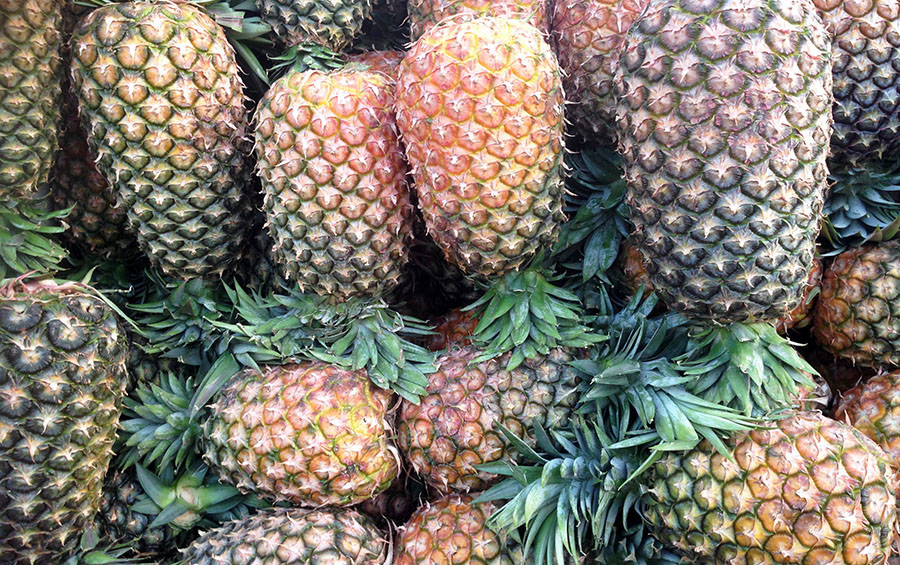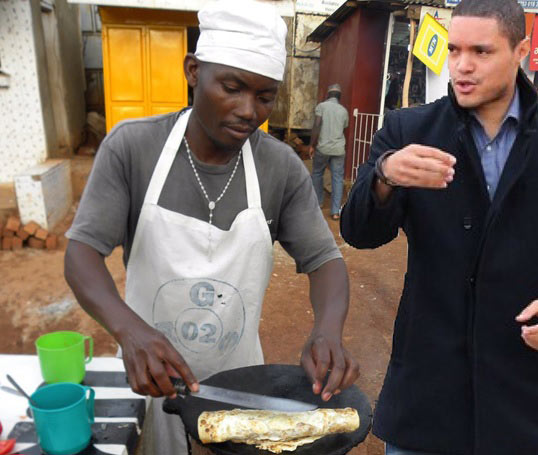
A virtual food tour of Uganda
Regular readers of Diary of a Muzungu know I’m always up for an adventure – and this one is in my tastebuds!
I was delighted when expat blogger Sarah ‘With a Smile’ Emery from sunny Singapore, invited me to take part in a virtual food tour. Here are some highlights of our interview about my experience eating different traditional foods in Uganda.
Sarah: What is your favourite traditional dish in Uganda?
The muzungu: “Katogo is popular, very filling and easy and cheap to prepare. The main ingredient is usually matooke (steamed green banana) or cassava or Irish potatoes, served with beans or beef. My favourite katogo combination is matooke with ‘g nuts’ (ground nuts or peanuts) and greens. Many Ugandans like breakfast katogo made with “gizzards” (not something I can stomach – no pun intended!) Katogo is served hot, normally in a bowl. It’s my kind of comfort food.”

Sarah: What is the most interesting food that you have eaten in Uganda?
The muzungu: “If you had told me 10 years ago that I would move to Africa and start eating insects, I may never have moved here! Insects – particularly cockroaches – were my biggest fear when I first moved to Uganda but now, I find myself eating – and LOVING – grasshoppers! Twice a year, when the rains are at their peak, the country has a glut of bright green grasshoppers or nsenene. At night, powerful lights attract the grasshoppers who are dazzled by the reflective glare of tin sheets and collected by the thousands.

Nsenene are peeled – just like prawns – by removing their legs and wings and then fried, often with onions. Grasshoppers give off a smoky flavour and once you start eating them, you may not want to stop. They’re delicious with an evening aperitif. They are high in protein and low in fat.
I haven’t tried them (yet) but enswa (white ants or termites) and lake flies are other Ugandan insect delicacies.”

Sarah: What is the worst food you have tried in Uganda and why?
The muzungu: “I was a vegetarian for many years and can’t imagine myself ever eating pig trotters. Friends say mulokony or kigere are quite a delicacy (“good hangover food”) but the sight of them, whether raw or cooked, is enough to turn my stomach.
When I first moved to Kampala, a young Ugandan friend introduced me to the traditional food of Western Uganda. The kalo (millet bread), served in a pretty woven basket, looked like raw dough and was served with a sour sauce derived from ghee. The dish is “an acquired taste”, shall we say, but even now, I can’t eat it.”

Sarah: What food and/or drink is a must-try for those who are visiting Uganda?
The muzungu: “The rolex is probably the country’s most talked about dish, particularly after it appeared on CNN. A rolex (think “rolled eggs”) is simply an omelette wrapped in a chapati, with the addition of sliced tomatoes and cabbage. The rolex was first made popular by Kampala’s university students. Nowadays, you can buy a freshly prepared rolex by any roadside. A few smart café’s in Kampala do ‘posh rolex’ with bacon or avocado but you can’t beat the original combo.
Read The rolex: celebrating Uganda’s uniqueness!

Another institution is Uganda Waragi, a triple-distilled gin which goes down a treat with tonic. It’s a popular tipple with tourists and expats. Waragi is said to come from the words ‘war gin’ and was an import of the British. Local gin is made of bananas and stored in plastic jerry cans. It can be lethal (and is best avoided!)
Bushera millet porridge is another popular staple which I tried on Agartha’s Taste of Uganda experience. Millet is a common crop and the porridge is drunk all over the country but at Agartha’s we experienced the whole process from ‘farm to cup.’ Her home in Ishasha was a tasty stop-over on our food tour of Uganda.
Read How to be a Mukiga woman – meet Agartha!

When I lived in Kampala, the capital of Uganda, a favourite day out was eating fish (Tilapia or Nile Perch) on Lake Victoria. Sometimes you want somewhere swanky, but sometimes you just want to sit at the landing site and eat the freshest fish with your hands. Read A guide to eating fish on Lake Victoria.”

Sarah: Are there any dining customs a visitor would benefit from knowing prior to visiting Uganda?
The muzungu: “Many Ugandans eat with their hands but it’s okay for you to eat with cutlery.
Lunch can sometimes take a long time to arrive, depending on the restaurant. A busy local restaurant will have ready-cooked food that they will quickly plate for you. However, if you make a specific order, expect to wait a long time. Unless you’re eating somewhere fancy in Kampala or at a tourist lodge, it’s good practice to ask “what is in the kitchen” since what is on the menu may have no bearing on what is available! The annoying part is that the waitress may not tell you for 15 minutes that this is the case. This seems to happen a lot outside the capital.
The food tour of Uganda continues. Read “Lunch arrived squawking on a boda boda.”

Ugandans add a lot of salt when they cook so always taste your food before adding any. Ugandans eat big portions. Every meal is a big slab of food. By contrast, Brits have smaller plates of food but are more likely to snack between meals. We may also order a starter or a dessert. Ugandans will generally just eat one course. (If fresh fruit is served at a buffet, it is normally piled on top of the other food!)
Uganda is a country of 56 tribes. This means that the food culture differs from one part of the country to another. In the central region of Buganda, it is deemed rude to leave a guest looking at an empty plate so a waitress may rush to remove your plate as soon as you finish eating. Culturally, she is exhibiting good manners, but I don’t like being rushed. (A Brit like me feels like the waitress is clearing the table ready for the next guest!)
Ugandan food is plentiful. The country has a wonderful climate meaning that there are at least two harvests per year. It’s perhaps for this reason that Ugandans don’t finish eating everything on their plate.

Ugandan avocados are HUGE and the pineapples and mangoes are the sweetest! Every visitor to Uganda comments on the fantastic fruit and vegetables. However, most Ugandans are happiest eating heavy carbohydrates (which they refer to by the collective name of ‘food’) and meat. Forget the paleo diet, Ugandans will load up their plates with as many as five types of ‘food.’
Vegetables or salads seem to be a ‘by the way’ and associated with poverty for many people. The thinking goes that if you have real food (meat and ‘food’) you don’t need to live on the free stuff (vegetables) that you can grow in your shamba.
When you visit a Ugandan home, it’s customary to be offered something to eat or drink. Your host may get upset if you don’t accept anything. Sometimes there will be an accompaniment with tea; this is sometimes called an ‘escort.’ (Uglish is a Ugandan version of English that often makes me smile).”




























I feel there is so much more I could write about Ugandan food. How could I miss Luwombo?
I love trying new foods and drinks wherever I go. Malwa and tonto are two local drinks that I could easily drink more of!
What else did I miss from this list?
Wow!!! Thank you for sharing some of my favorite dishes. Uganda is always amazing with a variety of dishes. Each region has different delicacies. This explains why Uganda rarely suffers from famine.
Hi Herbert thanks for dropping by. Uganda’s diversity of tribes combined with the diversity of landscapes (and growing conditions) make for a very fertile food menu! I love how each region has its own specialities. We should be showcasing these more, don’t you think?
“If fresh fruits is served at a buffet, it is normally piled on top of the other food”….
Hahahahahahah Nagawa tori mwangu!!
Lol.
Have seen it many times, especially at weddings!
I miss the fruits and the huge avocados! And matooke!
Uganda’s fruits and vegetables really are unbelievable aren’t they?
Also rumor has it that some tribes in northern uganda eat wild birds . They will hit a bird with a y shaped trigger ( butida ) off the ground, kill it and roast for food. Lol
A butida sounds like a catapult? In the UK naughty young boys used to use them to kill birds – for sport! 🙁
Oh yea catapult
I seriously enjoy your well thought articles! As for my favourite dish,please give me or serve me a whole deep fried Tilapia fish with vegetables or served with chips, I will not complain!!
Deep-fried tilapia with chips is a classic. But you are Ugandan, why are you ordering vegetables?! LOL Chris.
Hope you are well! I’m in Fort Portal this week… let’s meet up!
Oh my word!
I have just chanced on this blog and have read your posts(from 2016!) to this! You are now a true Ugandan-what with all the experiences from all over the place! You have def lived it like a Ugandan!
The food…malwa is a bit eewy! Yeah,a bit of game meat maybe? Oba still tolya nnyama??
Katunkuma ne doodo??
Omubisi(the sweet drink made from ripe bananas-embidde ne musa)?
Roasted sweet potatoes?
Eboo?
Eish,theres lots and lots more to taste!
Quite interesting and fun and a must read!!! Wont miss it again!!
Weebale nnyo!
Hi ESK
Thanks for dropping by. You’ve read four years of my blog? You get the Reader of the Week Award 🙂
I love doodo (had it for lunch today) and nkati.
Roasted sweet potatoes. Oh yes, a winner! Mind you, deep-fried cassava with salt on the side is very tasty too.
Game meat? I was a vegetarian when I moved to Uganda. I got bored of all the ‘food’ [see explanation above] and beans and the lack of vegetables so I started eating meat again. I’m rather a fussy meat eater. You will never find me eating: bush meat, fish eyes, chicken feet or ‘gizzards!’ As for game meat, I will only eat farmed game meat if I know where it comes from. (My first job in Uganda was as a volunteer on anti-poaching projects.
I like the ripe ‘banana juice’. I tried it when I was in Rwanda. (Is it the same?)
If you enjoy my stories, you’re welcome to sign up to my occasional newsletter.
What about gonna (roasted banana)
Yams
Mugoyo (pounded sweet potatoes with beans)
Have u tried mukene put in katogo (silver fish)
Fruits mpafu mapeera ntutunu
And lastly kikomando , pilao
For juice look for omubisi (made from ripe bananas mashed to get juice out of it)
Some delicious additions to my list – thank you Ephraim.
I love gonja but I draw the line at mukenne. Far too smelly! (I know it is highly nutritious however so I will est it – with my eyes closed!)
Of course I love pilau and ekikomando (beans with chapati).
Thanks Diary of a Muzungu for your posts. Everyone appreciates.. When I read them feel like not leaving.
Hey Nick, my neighbour thanks for dropping by. I’m delighted you like my stories. Thanks for being a part of them. Webale mununga 🙂
Really cannot wait to enjoy the Nsenene (grasshoppers) again this coming season. Most people especially Rwandese don’t eat them I really have no idea why ??
Have you tried Kikomando ( chapats and beans)
I like your blogs !!! Charlotte
Hi Hillary, thanks for taking the time to comment 🙂 It means a lot to me.
Firstly, kikomando is a GREAT meal!
Secondly, me too – I’m looking forward to eating nsenene again!
Interesting how Ugandans eat grasshoppers but people don’t in neighbouring countries. In fact, the truth is not all Ugandans eat grasshoppers do they? It’s a central region thing isn’t it?
One time I discussed eating grasshoppers with a Kenyan. Read Grasshoppers – eat them or smoke them? Discuss!
Northern Uganda is big on vegetable stews in peanut sauce .Boo ,malakwang ,sleep,otigo are some of the vegetables.Other legumes like angira , lapna and beans too. Meats and fish are usually smoked or salted and peanut or sesame/ simsim paste are added to thicken the stew. Angara orvsilver side fish with thousands of bones is common on lake Albert.It takes alot of skill to sort the bones from the flesh in the mouth before swallowing
I’ve seen Angara fish on sale by the side of the road. It is smoked isn’t it? I do love smoked fish (thanks for warning me about all those bones!)
I would love to explore northern Uganda more and the food sounds really interesting. I think we should organise a trip together one day!
Great piece…..during my years at the oldest Uni in Uganda. I always asked for a tiny portion of emere (mashed bananas-matooke) from the hall of residence DH, I like rice …The lady serving food would tell her colleagues that this guy doesn’t like food give him more rice…so basically anything without matooke is not food….it’s just a snack in ganda culture, I come from the North and our staple food is kalo (millet bread). True im the north they eat birds shot with catapult also rats are a delicacy 🙂
Hi Jeff, thanks for passing by… I prefer whole matoke rather than mashed emere but I eat both.
I LOVE your story! “This guy doesn’t eat food!” That has really tickled me.
I want to try more food from northern Uganda (except the RATS!) LOL. I really enjoyed trying some new foods when I was in Arua. Read 10 little-known things to do in Arua.
Oh great! awadifo for the link….Arua happens to be where my late dad grew up from, I visit once in a while, was last there in 2015 planning to go back soon. Will checkout Cafe Cosmo 🙂 . Incase you return lookout for a border market in Vurra where traders from Uganda and Congo sit facing each other, the gap which is the border is about half a metre.
Hi Geoff, thanks very much the recommendation. AWADIFO back at you! 🙂
I was talking to a friend from Arua today and told him I would like to revisit very soon… I found my stay there super interesting. Have you read my Arua blog?
You are welcome, will send you a very interesting pic of that market on facebook, yes sure I read the Arua blog, the only thing hadn’t done is eat at Cafe Cosmo (actually didnt know about it).
Thank you Geoff! I look forward to seeing Vurra market.
I love this pic, thank you! And the story is amazing!
Geoff writes “I promised to send you a pic of this interesting border market in Arua, West Nile. So on the left is named Kampala market and right is Kinshasa market middle is the border. I’m told it opens thrice a week.”
My favorite is the nsenene…. Ooh so delicious.
I actually really love grasshoppers now. I put off trying them for a long time because all I could think about was wings and legs getting stuck in my throat! LOL.
I find them very tasty now. I think of them as ‘land prawns.’ I love seafood and grasshoppers are quite similar to prawns, they just live on the land…
Thanks for dropping by Wilson 🙂
Matoke with groundnut sauce cooked with dodo
Yes yes yes! My favourite ‘comfort food!’ That’s my no. 1 preferred katogo recipe 🙂
Finally! The Muzungu herself has provided me with an explanation for waiters grabbing dishes that isn’t simply “they don’t have enough plates”.
LOL Miha!
But isn’t it annoying? I feel like I am being chased!
Give me a minute and I may order something else… but grab my plate too quickly and I won’t feel welcome (and you may lose your tip!)
You see how you Brits take small portions and snack in between meals: traditionally, we would have a heavy breakfast before setting off to work the land or to take the animals for grazing; in the middle of the day we would snack on fruit that grew freely in the wild and in people’s land (it is only in these days that fruits are sold, they used to be free and it was okay if you saw a fruit tree, climbed and got some fruits for yourself and for the owner of the tree before you went on your way). With land holdings becoming smaller and with trees getting cut to make way for modernisation and also for firewood, charcoal and timber; fruit consumption is not much a part of our life except for those in the villages.
Fruits also were a readily available option in the absence of food and that’s why some people look at fruit as a poor man’s food option.
The other issue is with how fruit is presented; if you put a whole mango besides a sliced mango: some might pick the whole mango (for consumption at a later time) instead of the sliced bits of mango.
Interesting to read your insights.
I imagine all traditional societies are / were much like this. Snacking is a fairly modern phenomenon. We focus on the convenience of snacking (but actually meals with family and friends are far more sociable aren’t they?) And evidence shows that modern lifestyles simply aren’t healthy.
Your reference to the mango reminds me of a funny story:
When I was working in Queen Elizabeth, a couple of UWA rangers jumped in our vehicle. As we drove to a remote area I passed around a packet of biscuits. Did I see them again?!
British way of thinking: be polite, hand the packet of biscuits so everyone can take one or two… [and pass them back to me].
Ranger way of thinking: put packet of biscuits inside uniform to eat later at personal convenience!
I was so shocked, I didn’t know what to say.
LOL.
Cultural differences are so interesting aren’t they?
[Sorry for slow reply. Your message was hidden in spam folder].